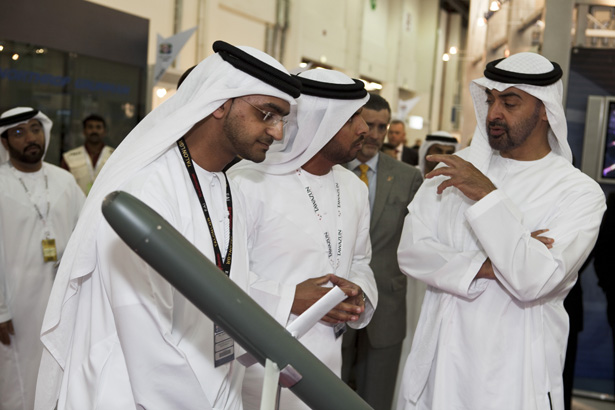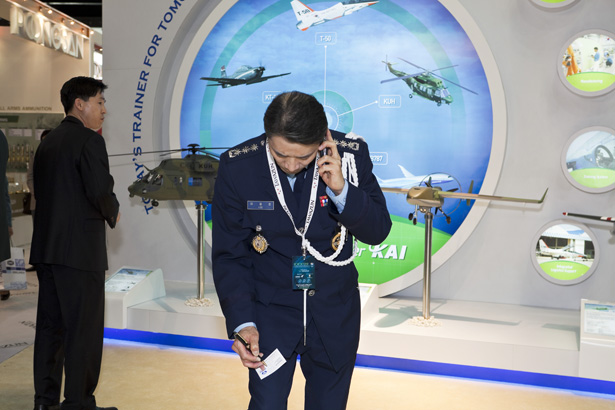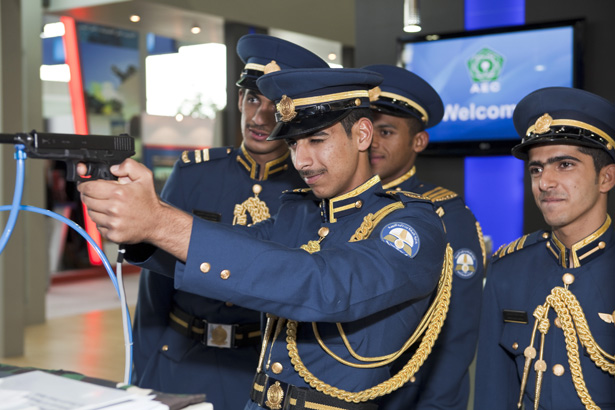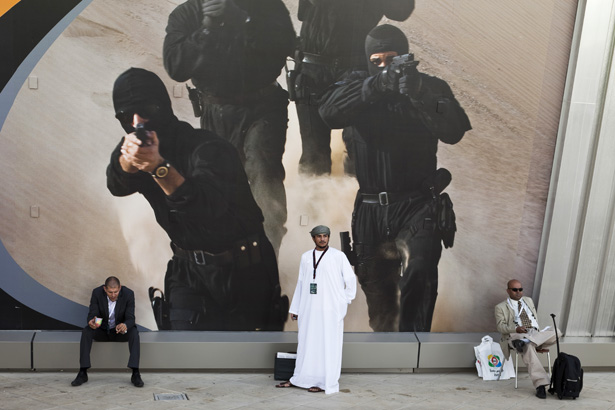I have photographed many fairs in my time, but this is the strangest of them all. I am at IDEX (International Defence Exhibition), at the Exhibition Centre in Abu Dhabi, one of the biggest arms fairs on the planet. It is strategically important because Middle Eastern countries are big buyers of arms, but also because the fair is so well positioned to attract delegations from around the world. One is aware of the volatility in the region, hastening defence spending up the agenda of these oil rich States. Over 150 delegations have come here with one thing in mind: to spend their defence budgets on the latest technology.
The fair starts on a Sunday, and this is the VIP day. Even on the other days of the fair, getting in is no easy matter: no public allowed, all potential visitors vetted and accredited with great care. VIP day is just like that, with a smattering of the press corps. After the opening ceremony, with singing and dancing from local schoolchildren and the inevitable fly-past, the delegates start cruising round, on a mission to spend. However unlike most fairs I have attended, not one price is displayed. I imagine these prices are very negotiable, depending on quantity ordered and scale of commitment. One thing is certain: everything is expensive. During IDEX 2007, (the fair is biannual) $545 million changed hands. This year however there are reports that contracts of over 20Billion US dollars are being negotiated.
The delegations range in size from a group of twenty to a handful of people. As they sweep through, the excitement is palpable amongst the dealers. So when the General Commander of Bahrain, or the defence minister of Pakistan, both of whom control defence spending, pass by your booth everyone is on their best behaviour. All questions are briskly answered, and if you are lucky someone from the party will stay behind to start the follow up discussions. Buying is a long process and rarely completed in less than a year, but for many arms deals IDEX is the starting line
Defence is riding the economic gloom very well. Not only were the budgets set well in advance of the credit crunch, but spending on “homeland security” and anti-terrorism is on the increase. Some dealers express concern for the future, but all countries have armies, and all countries want to ‘protect the people.’ This brings me to my next topic. The language emanating from the constant stream of AVs that play as you walk around is curiously deceptive. Sometimes phrases like “Ever changing global environments create opportunity” or “ In uncertain times” make you wonder if you are at an alternative health event, rather than one dedicated to military tools and technologies.
Stands are allocated to firms from different countries and not surprisingly the biggest area was taken by the UAE. However there were some surprises, such as the scale of the Turkish arms industry (very large indeed). I am told they have very good prices and appeal to countries on very tight defence budgets. The UK area seems rather small, given that the UK is the second biggest manufacturer of arms after the US, but I am told that many companies are now conglomerates and companies partly owned by the British can be found all round the fair. I meet a British man demonstrating a gun to an Arab. He asks me not to use the photo, for fear that his friends and even his own grandfather find out what he really does for a living. He tells them he is in the import/export business, which is strictly correct. ‘There is still a stigma attached to this business, and I operate in the grey area of arms exports’, he says.
It’s day two and there are now many more visitors and contracts are being started or even signed, although these may well be the ones begun over a year ago. I am passing the Lockheed Martin stand when suddenly the Mother of all Delegations shows up, for it is the Prince Royal of UAE. Although the President is technically the Commander in Chief of the UAE armed forces and the Prince Royal is his deputy, people know it is the Prince Royal who oversees defence spending. He is very knowledgeable on these matters, and it becomes clear that he talks the business of defence in a most articulate manner. His entourage is the biggest I have yet seen, swelled by a substantial number of press, bodyguards etc. He is greeted at the stand as a super hero. This is not suprising as UAE are about to sign a deal with Lockheed Martin for US $7 billion, for a missile defence system called THAAD – Terminal Area High-Altitude Defence – which to you or I is a way of shooting down ballistic missiles in outer space. This is the first country outside of the US who will be given permission by the US Congress to operate the THAAD. I follow this group as the delegation moves round, for this is the ultimate VIP, and companies are given a few moments’ notice before his arrival. He leaves as quickly as he arrived.
In the evening I go to the IDEX dinner at the Emirates Palace Hotel. This vast mausoleum feels like a cross between Ceausescu’s Palace and a shopping mall. Such is the scale of the complex that the fountains outside, with the hotel in the background, attract a keen tourist crowd. I realise that a reception for Sotheby’s upcoming auction in nearby Doha is also taking place in the hotel. I float in and suddenly feel more at home in the familiar world of art auctions. Despite walking round IDEX for 3 days and having many conversations, how the defence industry operates remains as mysterious to me as when I started.
February, 2009






Comments are closed.